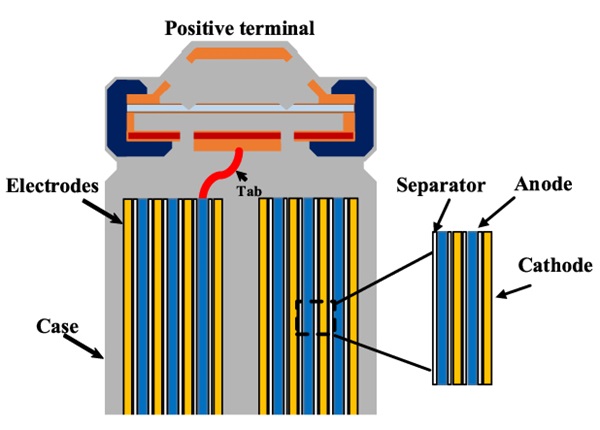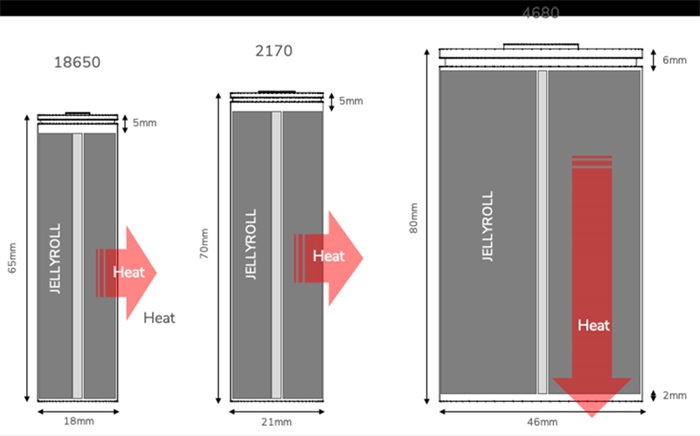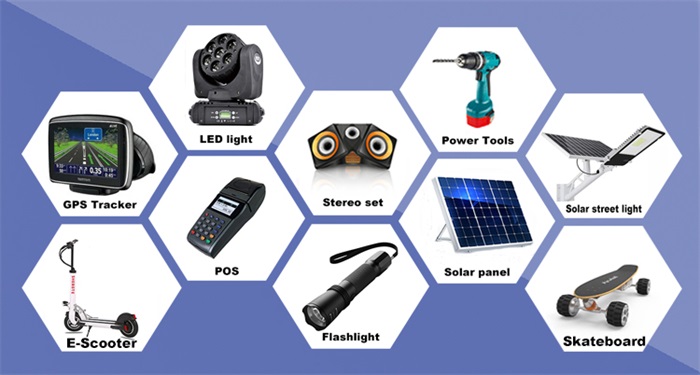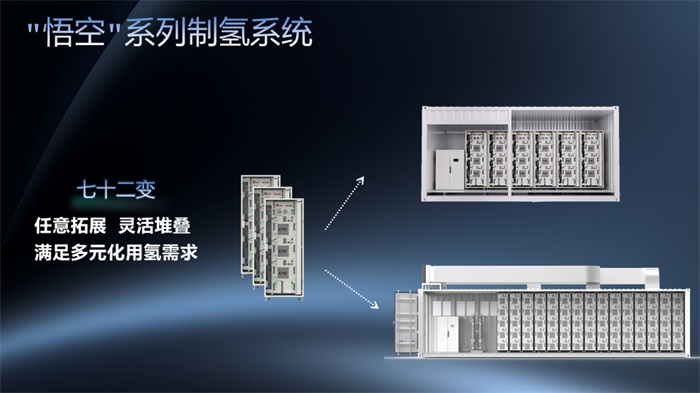In-depth discussion“what is an li-ion 18650 cylindrical lithium battery?”
The 18650 cylindrical lithium battery is a commonly used lithium-ion battery, named for its dimensions: a diameter of 18 millimeters and a length of 65 millimeters. This type of battery has a large capacity and is widely used in applications such as power tools, portable electronic devices, and electric bicycles. The positive electrode typically uses chemical materials such as lithium cobalt oxide, lithium manganese oxide, or lithium iron phosphate, while the negative electrode is composed of carbon materials. The separator is usually made from high-quality plastic polymer materials. The electrolyte is a colorless, transparent liquid, usually a mixture of lithium salts and organic solvents. The metal casing is typically made from corrosion-resistant materials like stainless steel, and the sealing device ensures the internal integrity of the battery.

Characteristics of 18650 Cylindrical Lithium Batteries
1. High Energy Density
One of the core characteristics of the 18650 battery is its high energy density. Energy density refers to the amount of energy a battery can store per unit volume or weight. Compared to other types of batteries, the 18650 battery provides a substantial amount of power within a relatively compact size, making it especially effective in applications where space and weight are critical. For instance, laptops, power tools, and electric vehicles rely on the high energy density of 18650 batteries to ensure prolonged power supply.
2. Long Cycle Life
The 18650 battery is renowned for its excellent cycle life. Cycle life refers to the number of charge and discharge cycles a battery can undergo while maintaining performance. Modern 18650 batteries can typically withstand hundreds to thousands of charge cycles, meaning users can utilize these batteries for extended periods without significant performance degradation. This long lifespan not only reduces the need for frequent battery replacements but also lowers the long-term operational costs of devices.
3. Stability and Safety
Safety is a critical consideration in the design of 18650 batteries. Modern 18650 batteries are usually equipped with multiple protection circuits to prevent overcharging, over-discharging, short-circuiting, and overheating. These protective measures help prevent safety hazards such as battery swelling, leakage, or explosion, ensuring user safety during operation. Additionally, 18650 batteries generally have high thermal stability, allowing them to operate reliably across a wide temperature range.
4. High Discharge Rate
The 18650 battery's ability to deliver a high discharge rate is another significant advantage, particularly in applications requiring high power output. High discharge rates enable the battery to release large amounts of current instantly, which is crucial for devices such as power tools and high-power LED flashlights. This capability ensures that devices maintain stable performance and reliable operation under high-load conditions.
5. Rechargeability
18650 batteries are rechargeable, meaning they can be charged and used multiple times without the resource waste associated with disposable batteries. The charging process typically involves specialized chargers to ensure safety and performance stability during charging. Rechargeability enhances the economic and environmental benefits of 18650 batteries in long-term use, reducing dependence on single-use batteries.
6. Flexible Applications
The design of 18650 batteries offers great flexibility in various applications. They can be used individually or assembled into larger battery packs. This versatility makes 18650 batteries suitable for a range of needs, from small portable devices to large energy storage systems. For example, multiple 18650 batteries are combined in series and parallel configurations to form high-capacity battery packs for electric vehicles, while a single 18650 battery is often sufficient for powering electronic cigarettes.
Differences Between 18650 Power Lithium Batteries and Regular Lithium Batteries
1. Design Objectives and Applications
· 18650 Power Lithium Batteries: These batteries are designed specifically for high discharge rates and high energy output. They are typically used in applications requiring high power, such as power tools, electric vehicles, and high-performance battery packs. These applications demand batteries that can deliver large currents over short periods and maintain stable performance under high loads.
· Regular Lithium Batteries: Regular lithium batteries focus more on providing stable energy supply and longer lifespan. They are widely used in consumer electronics like smartphones, laptops, and digital cameras. Their design emphasizes long battery life rather than high power output.
2. Discharge Rate and Energy Density
· 18650 Power Lithium Batteries: These batteries have a high discharge rate, capable of delivering large currents instantly, making them suitable for high-power applications. While they also have high energy density, their primary feature is their ability to handle high discharge currents without significantly affecting battery life or safety.
· Regular Lithium Batteries: Regular lithium batteries typically have lower discharge rates and are designed for stable energy release rather than high instantaneous current output. They have high energy density but are not as capable as power lithium batteries in terms of discharge ability. This makes regular lithium batteries excel in providing stable power over extended periods.
3. Cycle Life and Stability
· 18650 Power Lithium Batteries: To meet high discharge demands, 18650 power lithium batteries generally have strong stability and a long cycle life. However, due to frequent high-power discharges, their cycle life may be somewhat affected. Therefore, the longevity of these batteries under high loads needs particular attention.
· Regular Lithium Batteries: Regular lithium batteries usually have a longer cycle life, supporting numerous charge and discharge cycles without significantly degrading performance. This makes them better suited for applications requiring long-term stable power. Their stability and lifespan are typically better under regular usage conditions.
4. Size and Design
· 18650 Power Lithium Batteries: As a standardized cylindrical battery, the 18650 battery has a fixed size, but its design is optimized for high discharge demands. The design focuses on heat dissipation and structural strength to support high power output and high current.

· Regular Lithium Batteries: Regular lithium battery come in various sizes and shapes, with designs more focused on compatibility with different consumer electronics. They are often designed in flat or other shapes to fit various devices but do not match the power discharge capability of power lithium batteries.
5. Safety and Protection
· 18650 Power Lithium Batteries: Due to their high discharge rates, 18650 power lithium batteries are equipped with multiple layers of protection, including overcharge, over-discharge, short-circuit protection, and temperature monitoring. These safety features ensure safe operation under high loads and prevent potential hazards.
· Regular Lithium Batteries: While regular lithium batteries also have basic safety features, their focus is on providing stable power. The protective mechanisms are designed more for preventing overcharge, over-discharge, and other common safety issues during regular use.
6. Cost and Application Areas
· 18650 Power Lithium Batteries: Due to their high-performance requirements, 18650 power lithium batteries have a higher production cost. They are primarily used in high-power and high-performance fields, such as electric vehicles, power tools, and high-power energy storage systems.
· Regular Lithium Batteries: Regular lithium batteries are less expensive due to their focus on long-term stability and cost-effectiveness. They are widely used in smartphones, laptops, and other consumer electronics.
Applications of 18650 Cylindrical Lithium Batteries
Power Tools: Such as electric scissors, drills, and hammers.

· Consumer Electronics: Including laptops, tablets, smartphones, and handheld game consoles.
· Electric Transportation: Such as electric bicycles, scooters, and cars.
· Home Smart Devices: Including solar-powered street lights, door locks, smoke detectors, and wireless surveillance systems.
· Toys and Models: Such as remote-controlled cars, airplanes, and robots.
· Medical Devices: Including portable blood pressure monitors, glucose meters, and heart rate monitors.
· Energy storage system: The growing interest in renewable energy sources is also increasing the use of 18650 batteries in home ess
· Military Equipment: Such as night vision goggles and laser sights.
· Industrial Equipment: Including drones and robots.

